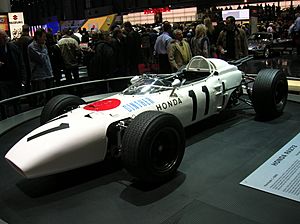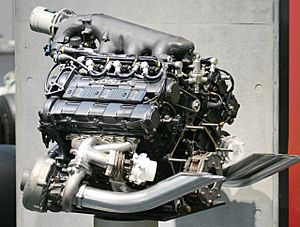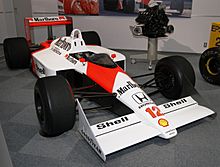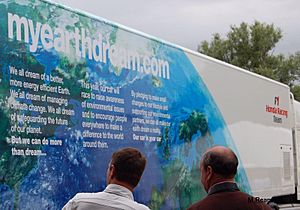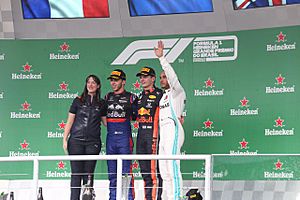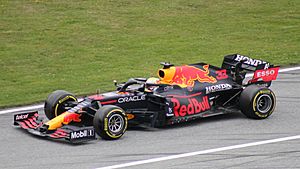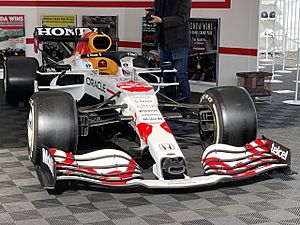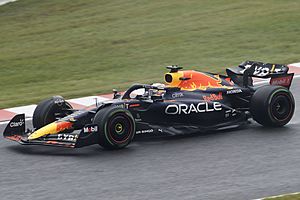Honda in Formula One facts for kids
| Full name | Honda Racing F1 Team (2006–2008) Honda R & D Company (1964–1968) |
|---|---|
| Base |
|
| Noted staff | Yoshio Nakamura Nobuhiko Kawamoto Yoshitoshi Sakurai Osamu Goto Takeo Kiuchi Ross Brawn Nick Fry Toyoharu Tanabe Masashi Yamamoto Yasuaki Asaki |
| Noted drivers | |
| Website | |
| Previous name | British American Racing |
| Next name | Brawn GP Formula One Team |
| Formula One World Championship career | |
| First entry | 1964 German Grand Prix |
| Races entered | 88 |
| Engines | Honda |
| Constructors' Championships |
0 |
| Drivers' Championships |
0 |
| Race victories | 3 |
| Podiums | 9 |
| Points | 154 |
| Pole positions | 2 |
| Fastest laps | 2 |
| Final entry | 2008 Brazilian Grand Prix |
| Formula One World Championship career | |
|---|---|
| First entry | 1964 German Grand Prix |
| Last entry | 2021 Abu Dhabi Grand Prix |
| Races entered | 482 (481 starts) |
| Chassis | Honda, Spirit, Williams, Lotus, McLaren, Tyrrell, BAR, Jordan, Super Aguri, Toro Rosso, Red Bull, AlphaTauri |
| Constructors' Championships | 6 (1986, 1987, 1988, 1989, 1990, 1991) |
| Drivers' Championships |
6 (1987, 1988, 1989, 1990, 1991, 2021) |
| Race victories | 89 |
| Podiums | 223 |
| Points | 3409 |
| Pole positions | 90 |
| Fastest laps | 76 |
Honda, a Japanese car company, has been a big part of Formula One racing since 1964. They have joined the sport as both a team owner and a company that makes engines for other teams. Since 2015, they have been making powerful hybrid engines for teams like Red Bull Racing and Racing Bulls.
Honda first entered Formula One as a full team in 1964. They won their first race in 1965 at the 1965 Mexican Grand Prix. After more success, Honda left F1 at the end of 1968. This was partly because they had trouble selling cars in the United States. Also, a Honda driver named Jo Schlesser had a fatal accident.
Honda came back in 1983, this time just as an engine maker. This was a very successful time for them. They won many races and championships between 1986 and 1991. They worked with famous teams like Williams and McLaren. Drivers like Nelson Piquet, Ayrton Senna, and Alain Prost won championships with Honda engines. Honda left F1 again at the end of 1992 after reaching their goals.
In 2000, Honda returned to F1 by providing engines for the British American Racing (BAR) team. BAR-Honda finished second in the Constructors' Championship in 2004. By the end of 2005, Honda bought the BAR team and renamed it Honda Racing F1 Team for 2006. They won a race in 2006 with Jenson Button. However, Honda announced in December 2008 that they were leaving Formula One because of the 2008 financial crisis.
Honda returned again in 2015 as an engine supplier for McLaren. Their first engines were not very competitive. After three years, McLaren and Honda decided to go their separate ways. In 2018, Toro Rosso started using Honda engines. Honda's engines improved quickly. Because of this, Red Bull Racing also decided to use Honda engines starting in 2019. Honda won their first race of the hybrid era in 2019 at the 2019 Austrian Grand Prix. Many more wins followed with both teams. The biggest success came in 2021 when Honda-powered driver Max Verstappen won the World Championship. Honda officially left the series after 2021 to focus on new technologies. However, they continued to supply engines to the Red Bull teams until the end of 2025. These Honda-built engines helped win more titles in 2022 and 2023. Honda will make a full return in 2026 with Aston Martin as their main partner.
As an engine maker, Honda has won six World Constructors' Championships and six World Drivers' Championships. They have also won over 80 Grand Prix races. This makes them one of the most successful engine suppliers in Formula One history. As a team owner, they have won three Grand Prix races. This makes them the only Japanese or Asian team to win in Formula One.
Contents
Honda's First Time in F1 (1964–1968)
Honda joined Formula One Grand Prix racing in 1964. This was only four years after they made their first road car. They surprised the European teams with their all-Japanese factory team. Only American drivers Ronnie Bucknum and Richie Ginther were not Japanese. For their first car, the RA271, Honda built both the engine and the car's body. This was something only a few other teams did.
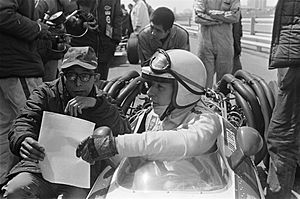
In just their second year, Honda won a race with Ginther driving the RA272 at the 1965 Mexican Grand Prix. For the 1966 season, Honda introduced the Honda RA273. This car had a powerful V12 engine. But the car's body was heavy and hard to handle. Honda won again in 1967 with the new Honda RA300, driven by John Surtees. This car won its first race at the 1967 Italian Grand Prix. The RA300's body was partly designed by Lola in the UK. This led to the car being called the Hondola. The team finished fourth in the constructors' championship that year.
The next year's car, the Honda RA301, had many problems. But it still finished on the podium twice and got one pole position. A new car, the Honda RA302, raced only once in 1968. It crashed badly, and driver Jo Schlesser died. This accident, along with Honda's desire to focus on selling road cars, made them leave Formula One at the end of the 1968 season.
Honda's Second Time in F1 (1983–1992)
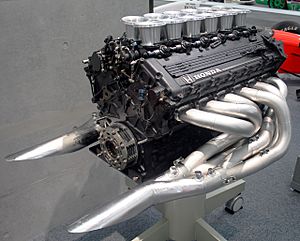
Honda returned to Formula One in 1983 as an engine supplier. They stayed in the sport for ten years. During this time, they worked with teams like Williams (1983–87), Lotus (1987–88), McLaren (1988–92), and Tyrrell (1991). Honda often supplied engines to more than one team. But they did not always give the same engine to different teams in the same year. For example, in 1991, McLaren got the newest V12 engine. Tyrrell, however, used an older V10 engine.
Honda's first race back was with Spirit's driver Stefan Johansson at the 1983 British Grand Prix. By the end of 1983, Honda started working with Williams. Keke Rosberg showed that the Honda engine was fast.
Rosberg gave Honda its first win as an engine supplier at the 1984 Dallas Grand Prix. By the end of 1985, it was clear that Honda had the best engine in Formula One.
At their best (1986–91), Honda engines were known for their power, reliability, and winning record. Honda was very dedicated to F1. Nigel Mansell, who drove Honda-powered Williams cars, said that Honda would develop many different engines in a single season. Honda won six championships in a row as an engine maker. They won two with Williams (1986–1987) and four with McLaren (1988–1991). They also won five drivers' championships in a row. These were won by Nelson Piquet (1987), Ayrton Senna (1988, 1990, 1991), and Alain Prost (1989). After this success, Honda left the sport again.
Honda's best year as an engine supplier was in 1988 with McLaren. The McLaren MP4/4 car, driven by Alain Prost and Ayrton Senna, had an almost perfect season. Honda built a new V6 turbo engine for that year. This engine helped McLaren-Honda get 15 pole positions out of 16 races. They also won 15 races. Senna won 8 races, and Prost won 7. McLaren-Honda scored a record 199 points in the Constructors' Championship. Senna won the Drivers' Championship that year.
For the new 3.5-liter engine rules in 1989, Honda introduced a new V10 engine. This engine was just as dominant. It helped Prost win the 1989 Drivers' Championship. In 1990, an improved V10 engine helped Senna win the 1990 Drivers' Championship. In 1991, Honda developed a brand new V12 engine. Senna used this engine to win his third World Championship. In 1992, the Williams car was better than any other. McLaren-Honda finished second in the Constructors' Championship. Honda's last win of this era was when Gerhard Berger won the 1992 Australian Grand Prix. Honda decided to leave Formula One after the 1992 season due to economic reasons in Japan.
By the end of 1992, Honda-powered cars had won 71 Grand Prix races. Most of these wins (69) were as an engine supplier between 1983 and 1992.
Honda's Third Time in F1 (2000–2008)
Return as an Engine Maker (2000–2005)
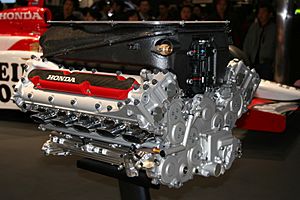
Honda returned to F1 again in 2000. They provided engines and support for the BAR team. They also supplied engines to Jordan Grand Prix in 2001 and 2002. In 2003, Honda decided to focus only on their partnership with BAR. In 2004, BAR had its best season, finishing second in the Constructors' Championship. This was only behind the dominant Michael Schumacher and Ferrari. In late 2004, Honda started to buy a larger share of the BAR team.
Becoming a Full Team (2006–2008)
In September 2005, Honda bought the rest of the BAR team. They became the sole owner. The team was renamed Honda Racing F1 Team for 2006.
2006 Season
Honda's first season as a team since 1968 started well. Jenson Button finished fourth in the first race and got a podium in the second. At the next race in Australia, Button got a pole position. But after that, the team's results were not consistent. They often had reliability problems. Pit-stop issues also caused problems for the team.
At the Hungaroring, things changed. Button started 14th but drove a great race to win his first ever F1 race. His teammate Rubens Barrichello finished fourth. After this win, the team's performance improved a lot. Button scored more points than any other driver in the last six races of the season. The team finished fourth in the constructors' championship with 86 points.
2007 Season
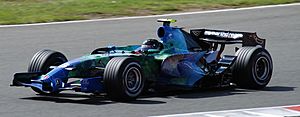
In 2007, tobacco sponsorship was banned in F1. Honda unveiled a new car design. The RA107 car showed planet Earth against a black background. The rear wing had the website address for myearthdream.com, an environmental awareness site. Reactions to this new look were mixed. But Honda won an environmental award for their "Earth Car" campaign.
The RA107 car was not very fast. At the first race in Australia, Button and Barrichello qualified poorly. They finished 15th and 11th. The team struggled to score points in the first few races. Honda finally scored a point at the 2007 French Grand Prix with Button finishing eighth. The team ended up 8th in the constructors' championship. Their best result was 5th place in China. Honda started hiring new aerodynamic experts to fix the car's problems.
2008 Season
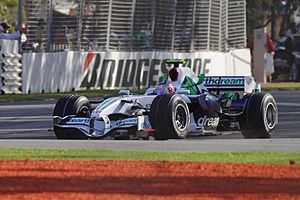
In July 2007, it was announced that Barrichello and Button would stay as teammates for 2008. Ross Brawn, a former Ferrari technical director, joined Honda as team principal. Honda launched their 2008 car, the RA108. The "Earth Car" livery was slightly different, with less of the earth picture.
Honda had another disappointing year in 2008. By mid-season, they started focusing on the 2009 car. Despite this, Barrichello managed to get a podium finish at the wet British Grand Prix.
Team Sale and Brawn GP
Honda suddenly left the sport at the end of the 2008 season. They did not want to continue spending a lot of money on the team during the 2008 financial crisis. The team kept working on the 2009 car while Honda tried to sell it.
The team was eventually saved by a group of managers led by Ross Brawn. It entered the 2009 season as Brawn GP. The team kept Jenson Button and Rubens Barrichello as drivers. Mercedes supplied the engines. Honda also provided some financial support for the first year. Brawn GP won both the drivers' and constructors' titles in its only season.
Honda's Fourth Time in F1 (2015–2021)
Return as an Engine Supplier to McLaren (2015–2017)
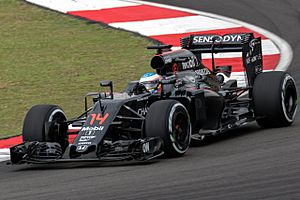
Honda returned to Formula One as an engine supplier in 2015. They restarted their partnership with McLaren. Honda's engine was designed to fit McLaren's very compact car design. In 2015, the McLaren-Honda package was not powerful enough and often broke down. The team finished ninth in the constructors' championship. Honda lacked experience with the new engine rules.
For the 2016 season, Honda made big improvements. By the sixth race, the team had already scored more points than in all of 2015. They finished sixth in the constructors' standings. In September 2016, Honda said they were already working on the next year's engine.
For the 2017 season, Honda completely redesigned their engine. This new design was "high risk" but promised better performance. The season started with many reliability problems. It took until the eighth race to score points. However, the team regularly scored points later in the season. They finished ninth in the constructors' championship. The relationship between McLaren and Honda became difficult. In September 2017, they announced they would split at the end of the year.
Working with Red Bull Teams (2018–2021)
2018: Toro Rosso
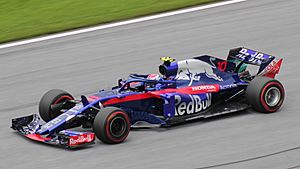
In September 2017, Honda announced they would supply engines to Toro Rosso for the 2018 season. Honda's 2018 engine was more reliable than the previous year's. In just the second race in Bahrain, the team finished fourth with Pierre Gasly. This was Honda's best result since returning in 2015. After seeing Honda's improvements, Red Bull Racing decided to switch to Honda engines for 2019. Honda then focused on gaining experience for 2019. The team finished ninth in the constructors' standings.
2019: Red Bull and Toro Rosso
In 2019, Honda supplied engines to both Red Bull Racing and Toro Rosso. This was the first time they worked with multiple teams since 2008. Honda and Red Bull worked closely to make the car and engine work perfectly together.
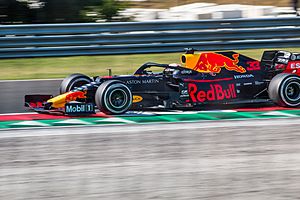
At the first race in Australia, Red Bull-Honda driver Max Verstappen took third place. This was Honda's first podium since 2015. Honda brought engine upgrades throughout the season. At the 2019 Austrian Grand Prix, Verstappen won the race. This was Honda's first win in the hybrid era. Another win followed two races later in Germany. There, Verstappen won, and Toro Rosso's Daniil Kvyat came third. At the next race in Hungary, Verstappen got his first pole position.
Honda introduced another engine upgrade in Belgium. Honda's performance was very strong at high-altitude tracks. In Brazil, Verstappen won from pole position. Pierre Gasly in his Toro Rosso-Honda finished second. This was Honda's first 1–2 finish since 1991. Verstappen finished the 2019 season third in the championship. Red Bull finished third in the constructors' standings. Toro Rosso had their most successful season. Honda had the fewest engine failures of all manufacturers that year.
2020–2021: Red Bull and AlphaTauri
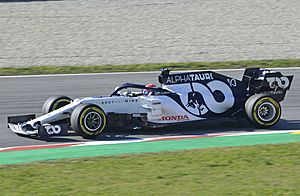
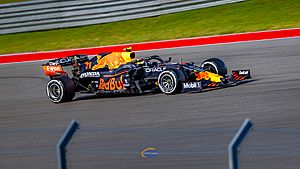
For 2020, the Toro Rosso team was renamed AlphaTauri. The Red Bull-Honda package was the second fastest team. Verstappen scored five podiums in a row. He also won the 70th Anniversary Grand Prix. At the 2020 Italian Grand Prix, AlphaTauri's Pierre Gasly won his first Formula One race. This made Honda the first engine maker to win with different teams in the hybrid era. Verstappen was again the top Honda driver, finishing third in the championship. Red Bull was second, and AlphaTauri was seventh in the constructors' standings.
In October 2020, Honda announced they would leave Formula One at the end of the 2021 season. They wanted to focus on new car technologies. Honda was still determined to win in 2021. They brought a new engine design for the 2021 season. This new engine was much better and more reliable. Verstappen took pole position at the first race and won the second. He became a strong title contender against Lewis Hamilton. Verstappen won five races in a row, a first for Honda since 1988.
Verstappen was involved in crashes at the British and Hungarian Grands Prix. He lost the championship lead to Hamilton. Honda introduced a new energy store for the Belgian Grand Prix. Verstappen then won the Belgian and Dutch Grands Prix. He regained the championship lead. He won two more races in the United States and Mexico. After three second-place finishes, he went into the final race tied with Hamilton. Verstappen won the 2021 Abu Dhabi Grand Prix on the last lap. He became the World Champion. This was Honda's first championship win in thirty years. Verstappen was the first Honda-powered World Champion since Ayrton Senna in 1991. AlphaTauri had their best points haul ever. Honda ended the season with the most wins.
Honda's Fifth Time in F1 (2026 onwards)
In December 2022, Honda officially said they were interested in being an engine maker for the new rules in 2026.
In May 2023, Honda confirmed their return for 2026. They announced they would supply hybrid engines to Aston Martin. This will be a full partnership. The new rules will make electric power a bigger part of the engines. Also, the cars will use 100% sustainable fuels. These changes helped convince Honda to return. Honda had worked with the Aston Martin team before, when it was known as Jordan Grand Prix in 2001 and 2002.
Other Involvement
Mugen Era and 1999 Project
From 1993 to 1998, Honda was in Formula One through its partner, Mugen Motorsports. Mugen supplied engines to several teams. Mugen-powered cars won four Grand Prix races. Honda engineers helped with these engines. By 1998, these engines were almost like official Honda engines. In 1998, Honda thought about entering F1 as a full team. They even built a test car, the RA099. This car was tested in 1999 by Jos Verstappen. The team did well in tests. But after the technical director had a fatal heart attack, the project was stopped. Honda decided to return as an engine supplier to BAR instead.
Continued Engine Supply to Red Bull (2022–2025)
| Formula One World Championship career | |
|---|---|
| First entry | 2023 Bahrain Grand Prix |
| Last entry | 2019 Monaco Grand Prix |
| Races entered | ( starts) |
| Chassis | Red Bull Racing, AlphaTauri, RB |
| Constructors' Championships | 1 (2023) |
| Drivers' Championships |
2 (2023, 2024) |
After leaving Formula One at the end of 2021, Honda agreed to keep building and supplying engines to Red Bull Racing and Scuderia AlphaTauri. This was possible because engine development was frozen for 2022. This allowed Honda to reduce its F1 work. They supported Red Bull as Honda RBPT (Honda Red Bull Powertrains). Honda Racing Corporation (HRC) took over the program. This agreement was first for 2022. But it was later extended to the end of the 2025 season.
In 2022, the Honda-designed engines were called Red Bull Powertrains (RBPT) units. Honda's logos on the cars were replaced by HRC. At the 2022 Japanese Grand Prix, Honda and Red Bull announced a stronger partnership. Honda branding returned to both Red Bull Racing and AlphaTauri cars. Honda returned as a named engine supplier for the 2023 season. The engines were called Honda RBPT.
Honda's 2022 engine design was strong and reliable. Verstappen won a record 15 races in 2022. He won his second championship in Japan. Red Bull won the constructors' title in the United States. At the 2023 Hungarian Grand Prix, Red Bull won their 12th race in a row. This broke McLaren's record from 1988. This also meant Honda broke its own record.
Honda has been part of discussions about future Formula One rules. They talked with different teams about partnerships from 2026. Honda will not continue with Red Bull. Red Bull has partnered with Ford for 2026. Honda then announced their full return to F1 in 2026 with Aston Martin.
Statistics
Formula One Car Results
- Winning percentage: 3.4%
| Year | Name | Car | Engine | Tyres | No. | Drivers | Points | WCC |
|---|---|---|---|---|---|---|---|---|
| 1964 | RA271 | RA271E 1.5 V12 | D | 0 | NC | |||
| 1965 | RA272 | RA272E 1.5 V12 | G | 11 | 6th | |||
| 1966 | RA273 | RA273E 3.0 V12 | G | 3 | 8th | |||
| 1967 | RA273 RA300 |
RA273E 3.0 V12 | F | 20 | 4th | |||
| 1968 | RA300 RA301 RA302 |
RA273E 3.0 V12 RA301E 3.0 V12 RA302E 3.0 V8 |
F | 14 | 6th | |||
| RA301 | RA301E 3.0 V12 | G | ||||||
| 1969 – 2005: Honda did not compete as a car constructor. | ||||||||
| 2006 | RA106 | RA806E 2.4 V8 | M | 11. 12. |
86 | 4th | ||
| 2007 | RA107 | RA807E 2.4 V8 | B | 7. 8. |
6 | 8th | ||
| 2008 | RA108 | RA808E 2.4 V8 | B | 16. 17. |
14 | 9th | ||
Formula One Engine Results
World Drivers' Championships Won
| Driver | Season(s) | Total |
|---|---|---|
| 1987 | 1 | |
| 1988, 1990–1991 | 3 | |
| 1989 | 1 | |
| 2021 | 1 |
Note: This table only includes engines/power units which were badged as "Honda":
* Max Verstappen won the 2022 Drivers' Championship with an RBPT-badged Honda power unit
* Max Verstappen won the 2023 Drivers' Championship with a Honda RBPT power unit
* Max Verstappen won the 2024 Drivers' Championship with a Honda RBPT power unit
World Constructors' Championships Won
| Constructor | Season(s) | Total |
|---|---|---|
| 1986–1987 | 2 | |
| 1988–1991 | 4 |
Note: This table only includes engines/power units which were badged as "Honda":
* Red Bull Racing-RBPT won the 2022 Constructors' Championship with a rebadged Honda power unit
* Red Bull Racing-Honda RBPT won the 2023 Constructors' Championship with a Honda RBPT power unit
Grand Prix Results
| Constructor | Season(s) | Total wins | First win | Last win | Pole positions | First pole | Last pole |
|---|---|---|---|---|---|---|---|
| 1964–1968, 2006–2008 | 3 | 1965 Mexican Grand Prix | 2006 Hungarian Grand Prix | 2 | 1968 Italian Grand Prix | 2006 Australian Grand Prix | |
| 1983 | 0 | – | – | 0 | – | – | |
| 1983–1987 | 23 | 1984 Dallas Grand Prix | 1987 Mexican Grand Prix | 19 | 1985 French Grand Prix | 1987 Mexican Grand Prix | |
| 1987–1988 | 2 | 1987 Monaco Grand Prix | 1987 Detroit Grand Prix | 1 | 1987 San Marino Grand Prix | 1987 San Marino Grand Prix | |
| 1988–1992, 2015–2017 | 44 | 1988 Brazilian Grand Prix | 1992 Australian Grand Prix | 53 | 1988 Brazilian Grand Prix | 1992 Canadian Grand Prix | |
| 1991 | 0 | – | – | 0 | – | – | |
| 2000–2005 | 0 | – | – | 2 | 2004 San Marino Grand Prix | 2005 Canadian Grand Prix | |
| 2001–2002 | 0 | – | – | 0 | – | – | |
| 2006–2008 | 0 | – | – | 0 | – | – | |
| 2018–2019 | 0 | – | – | 0 | – | – | |
| 2019–2021 | 16 | 2019 Austrian Grand Prix | 2021 Abu Dhabi Grand Prix | 13 | 2019 Hungarian Grand Prix | 2021 Abu Dhabi Grand Prix | |
| 2020–2021 | 1 | 2020 Italian Grand Prix | 2020 Italian Grand Prix | 0 | – | – | |
| Total | 1964–2021 | 89 | 1965 Mexican Grand Prix | 2021 Abu Dhabi Grand Prix | 90 | 1968 Italian Grand Prix | 2021 Abu Dhabi Grand Prix |
Note: This table only includes engines/power units which were badged as "Honda"; it does not include the 1992–2000 Mugen Honda engines, the 2022 RBPT power units (which were rebadged Hondas) or the 2023–2025 Honda RBPT power units.
See also
 In Spanish: Honda en Fórmula 1 para niños
In Spanish: Honda en Fórmula 1 para niños
- Honda in motorsport
- Mugen Motorsports
- Honda Grand Prix results


